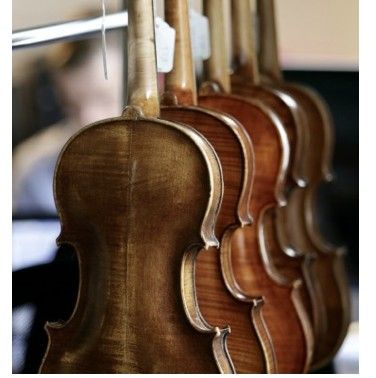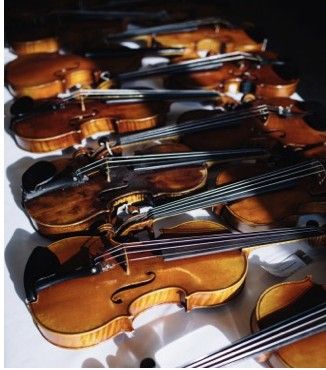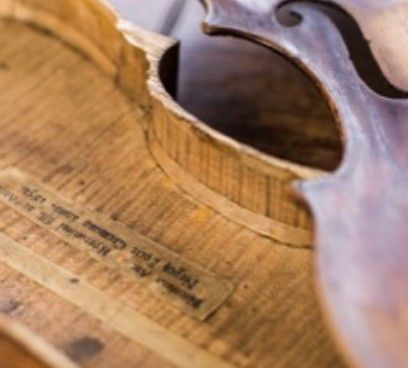Find Your Violin Worth Today
Alexander SMILLIE
He was born at Hallside, Cambuslang, Jan. 25, 1847. His workshops are at 130 Shamrock Street, and 514 Victoria Street, Glasgow, where also he carries on extensive business as a repairer and dealer. He is the son of John and Margaret Smillie. He was married April 27, 1876, to Janet Andrews, at Cordonald, near Paisley. He has six children — three sons and three daughters — viz., John, Andrew, Alexander, Margaret, Nellie, and Bessie. The second son, Andrew, has started work with him since the recent opening of the new premises in the West end, Mr. Smillie received elementary education at the Cambuslang Parish School, but he received no early training in the art of violin-making. His first instrument was not made till 1889, but since then he has been pretty busy, seeing that he has turned out 160 violins, 15 violas, and 13 violoncellos. These instruments show excellent work, and they place Smillie in the front rank of modern makers. He works on the Stradivarius and Guarnerius lines, but he is not a mere copyist. The measurements of the outline and model after which he most frequently works are as follows : — Mr. Smillie cuts his backs on the various methods, according to the nature of the wood he happens to be using. In two of the instruments examined by me it was cut on the slab, and it is difficult to imagine anything more beautiful than the effect produced. When the fiddle is held horizontally, the eye is dazzled by cloud-like coruscations of golden sheen ; and when it is tilted to an angle of forty-five degrees, the clouds are metamorphosed into a hundred " milky ways." Given a piece of suitable wood, of ample width, a back cut on the slab is second to none in artistic merits. This maker uses old wood, especially for the front tables, and, as he is able to test it acoustically, it is invariably of excellent quality. The grain of some of the pine is very wide. In an example now before me, it is exactly -f of an inch wide towards the margins — straight, and well-defined. On either side of the finger-board, and running into the long axis of the sound-holes, is a narrow line of light-brown stain, extending right along the instrument. The stain was probably produced by an unusual colouring of the cambium cells during growth. As several of Mr. Smillie's instruments show traces, more or less pronounced, of this stain, their tables must have been cut from the same piece of timber. The outline combines the graceful and the bold. The waist is full, and rapidly extending in width as it approaches the lower bouts. This gives a sense of solidity to the build as it also adds to the firmness and roundness of tone. The arching is moderately full and extended. The upper bouts are more rounded than is usual with Strad, but a nice balance is thus obtained between the upper and middle parts of the instrument. The scroll is magnificently sculptured. The coulisses or grooves round the back and head are deep, and the lines very sharp. The lines of the volute are also sharp and cut with mathematical precision. The throat is as carefully finished as the head. The peg-box is strong, with sides about 1/5 of an inch thick. The scollop projects a trifle more than it usually does in Italian instruments, but it befits the scroll. The button is of medium size and in the best classical style. The sound-holes are simply beautiful. They are moderately wide, and just a shade shorter than the grand period holes of Strad. The upper turns are also rather smaller, but very pretty. They are set farther away from the edge than is usual with Strad, and about 1/16 (or more) of an inch lower down, and they do not incline so much — the angle of inclination being about eighty degrees. The sound-holes are set in with a true artistic feeling, and the effect produced on the mind in viewing the general appearance of the front table is that of repose and freedom. The purfling is inlaid with accuracy. The margins are of medium width, and the edges strong and rounded. The depth of the edge is 3/16 of an inch, and it is raised about 1/16 culminating midway between the outer line and the purfling in a very pretty and gentle ridge. The corners are in the style of Riechers, with the "wasp's sting" of the purfling reaching very nearly to the inner angles. Mr. Smillie's 'cellos are considered to be equal to, if not better than, his violins. Their tone is grand and mellow, and remarkably free and full on all the positions. Mr. Smillie has never exhibited any of his instruments. He is a patient, unassuming worker, and the spirit of rivalry is foreign to his nature. His rare humour and genial manner have made him numerous friends in the great fiddle world.
Show more Hide textPrice History
| Type | Title | Sold | Price |
|---|---|---|---|
| Violin | 35.8 cm Glasgow, 1907 | Sat 1st October 11 | £ 3125.00 |
| Violin | 35.6 cm Glasgow, 1911 | Wed 1st February 06 | £ 1800.00 |
| Violin | 1905 | Thu 1st November 90 | £ 2090.00 |
| Violin | 1911 | Tue 1st September 87 | £ 1430.00 |
| Violin | 1915 | Fri 1st November 85 | £ 864.00 |
| Violin | 1896 | Sat 1st November 03 | £ 1645.00 |
| Cello | 1912 | Thu 1st February 01 | £ 11730.00 |
| Violin | 1911 | Wed 1st November 00 | £ 3290.00 |
| Violin | 1923 | Fri 1st September 00 | £ 748.00 |
| Violin | 1896 | Mon 1st May 00 | £ 2933.00 |
| Violin | 1933 | Sun 1st November 98 | £ 747.00 |
| Cello | 1892 | Wed 1st October 97 | £ 1600.00 |
| Violin | 1899 | Sat 1st June 96 | £ 2645.00 |
| Violin | 1896 | Wed 1st February 95 | £ 1552.00 |
| Violin | 1915 | Thu 1st March 90 | £ 880.00 |
| Violin | 1898 | Fri 1st September 89 | £ 1705.00 |
| Violin | 1894 | Wed 1st June 88 | £ 594.00 |
| Violin | 1894 | Sun 1st November 87 | £ 506.00 |
| Violin | 1911 | Sun 1st November 87 | £ 825.00 |
| Violin | 1909 | Sat 1st November 86 | £ 572.00 |
| Violin | 1895 | Mon 1st July 85 | £ 484.00 |
| Violin | 1893 | Thu 1st November 84 | £ 440.00 |
| Violin | 1894 | Wed 1st June 83 | £ 605.00 |
| Violin | 1901 | Tue 1st June 82 | £ 280.00 |
| Violin | 1896 | Sat 1st March 80 | £ 108.00 |
| Viola | 40.3 cm 1912 | Sun 1st January 84 | £ 607.00 |
| Violin | 1911 | Mon 1st November 82 | £ 550.00 |
| Viola | 1912 | Sun 1st March 81 | £ 769.00 |
Similar Makers
Books by Amati
Amati, in collaboration with leading experts, have published a few key books in the field of stringed instruments.
Explore more


